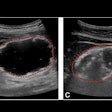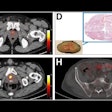Best Radiologist Training Program
Minnies 2025 Winner: University of Pennsylvania, Philadelphia, PA
Penn is back on top of the Minnies in this category, winning the battle of the Keystone State. This marks the third time in four years that Penn has earned the Best Radiologist Training Program.

For Mary Scanlon, MD, vice chair of education, the award means the world.
“Our philosophy is to train our residents with the expectation that they will define the future practice of radiology, not just practice the status quo,” Scanlon said. “That whether they go into academics or private practice, they will be the leaders of those practices across multiple possible domains.”
It’s not hard to see why Penn has demonstrated dominance in recent years in this category. The program supports multiple tracks in research, healthcare leadership, and Tomorrow's Educators and Clinicians in Healthcare (TEACH). Trainees can also focus their interests on informatics and global health.
Penn Radiology offers two residency programs in diagnostic and interventional radiology. The diagnostic radiology program has research and clinical tracks. The interventional radiology program at the Hospital of the University of Pennsylvania offers three separate residency tracks. These include a five-year integrated interventional and diagnostic radiology residency program, a one-year independent residency program, and a two-year independent residency program.
And trainees can hone their skills with hands-on work with the department’s imaging scanners and suites. These include C-arm suites, a CT-fluoroscopy suite, a venous ablation suite, and pre- and postprocedural suites.
Scanlon also serves as residency program director for diagnostic radiology and associate program director for integrated interventional radiology residency. She said the people, including staff, faculty, and students, make the program stand out.
“It’s a program that is in a constant state of trying to tweak perfection,” she said. “It’s a program that supports, values, and celebrates the trainee wholly, not just their minds.”
Penn Radiology also provides one or two-year fellowships in eight clinical subspecialties, as well as postdoctoral research fellowships in both basic and clinical disciplines.
These offerings aim to prepare aspiring radiologists for the “enormous” changes they may see in their careers, including those related to technology, practices, organization, and policy.
Program benefits include allotting academic time for research and the department providing home read workstations, rotation tuition, conference reimbursement, and an allowance for education and professional funds.
Congratulations to Penn on getting back to the top!
Runner-up: Allegheny Health Network, Pittsburgh, PA
Best Radiologic Sciences Program
Minnies 2025 Winner: Quinnipiac University, Hamden, CT
Quinnipiac finally gets its first Minnies award in this category since the category’s creation in 2001. The university is no stranger to being named a Minnies finalist, but the past couple of years have been kind to the Bobcats.

Program director Kori Stewart, PhD, won the Minnie for Most Effective Radiologic Sciences Educator in 2024. And this year, the work that she and her colleagues have put their effort into is being recognized again.
“We’re super grateful to whoever nominated our program,” Stewart said. “We’re just so truly honored to be recognized. The Minnies community is absolutely some of the best of the best.”
Quinnipiac offers a three-year Bachelor of Science in Radiologic Sciences, with students able to opt for a one-year Master of Health Science degree in advanced medical imaging and leadership. It also offers a Bachelor of Science in Diagnostic Medical Sonography and a minor in Global Public Health.
Students can take advantage of combined classroom, lab, and clinical experiences to gain knowledge about radiology and radiation safety. All students participate in clinical rotations in both the second and third year of the program. They can also work in clinical rotations at affiliated health systems in Connecticut and Massachusetts to gain more experience. Students in their final year are eligible to sit for the American Registry of Radiologic Technologists (ARRT) certification exam.
And the program has numbers to back up the university’s claims, including an average first-time certification pass rate of about 84% over the past five years, a 100% job placement rate, and a 94% program completion rate in 2024.
Stewart, an alumnus of the university, said the university invests in its people to prepare competent and compassionate imaging professionals “who essentially elevate the standards of medical imaging and patient care.”
“We do that through a really student-centered approach, looking at academic excellence, hands-on learning, and mentorship,” Stewart said. “They are trained in energized, state-of-the-art radiographic labs that replicate real hospital environments. Quinnipiac takes pride in our entire diagnostic imaging suite.”
The interdisciplinary team at Quinnipiac has “decades” of experience in breast imaging, CT, MRI, interventional radiology, and ultrasound, among other imaging specialties. The instruction reflects current practice in cutting-edge technologies, Stewart added.
Runner-up: Mayo Clinic College of Medicine and Science, Rochester, MN
Most Significant News Event in Radiology
Minnies 2025 Winner: Impact of NIH funding cuts on medical imaging research community
The U.S. government has been in shutdown since October 1, and since the stoppage affects the federal budget, the level of cuts to the U.S. National Institutes of Health (NIH) that could be enforced remains unclear -- which has been causing consternation among medical imaging researchers.
Professional imaging organizations have been tracking potential cuts to the NIH at least since March, when the institute announced that grants and funding policies and processes were "evolving" as the NIH aligned with "new agency priorities."
The news had an immediate effect on radiology, as researchers and policy experts sought to navigate the changed landscape. By May, academic radiology researchers continued to grapple with the "coming new normal" after the NIH's apparent $18 billion funding cut to health research spending.
As of May 6, the Association of American Medical Colleges estimated NIH grant terminations would be $1.9 billion for all U.S. institutions combined, and just over $1 billion for medical schools and hospitals. At the end of that month, President Trump released a full federal fiscal year 2026 budget; in a June 4 statement, the American College of Radiology (ACR) warned that the proposed budget included a cut to the NIH of approximately $18 billion compared with 2025 levels, and it vowed to continue advocating for increased NIH and Advanced Research Projects Agency for Health (ARPA-H) funding.
In September, appropriations bills made the rounds in Congress. One advanced by the U.S. House Committee on Appropriations Subcommittee on Labor, Health and Human Services, Education, and Related Agencies (Labor-HHS) provided $48 billion for the NIH and included funding for all 27 NIH institutes and centers, and did not implement President Donald Trump's budget request to cut NIH funding to $27.5 billion. The Senate Committee on Appropriations' version of the bill proposed NIH funding of $48.7 billion.
Both bills remain unresolved. AuntMinnie will continue to monitor the government's shutdown status and legislation that will affect the NIH's funding.
Runner-up: CT estimated to cause 5% of new cancer cases
Biggest Threat to Radiology
Minnies 2025 Winner: Radiology workforce shortage
For the third year in a row, our expert panel recognized workforce shortages as the biggest threat to radiology, with recent reports all but confirming these concerns.
Studies published in 2025 found that about two out of three academic and hospital radiology practices reported being understaffed, and nearly half of radiologists in a separate survey reported workforce shortages as their top concern. The same survey also found that pediatric radiology continues to experience a major shortage. And if no efforts are made, the current supply of radiologists in the U.S. and increased demand for imaging are projected to lead to a continued workforce shortage.
As for radiologic technologists, the American Society of Radiologic Technologists in July reported that employee vacancy rates increased for CT, MRI, and bone densitometry, with CT reaching an all-time high.
Experts told AuntMinnie that these shortages may stem from job candidates disagreeing on salary expectations, poor communication, a competitive job market, and more emphasis on work-life balance.
Workforce shortages also create more problems for practices, including increased risk of burnout for staff and delays in patient care. However, leaders in radiology, radiologic technology, and radiation oncology are taking action and showing their resilience and adaptability.
The ASRT, the American College of Radiology, the Society of Diagnostic Medical Sonography, the Society of Nuclear Medicine and Molecular Imaging, and other societies have created a joint workforce action plan that aims to raise awareness of multiple roles within radiology and radiation oncology.
Can AI help? Experts believe it could enable significant efficiency gains in a number of applications, such as streamlining the radiology reporting process. However, it will likely take more than just new technology to make meaningful progress on the radiology workforce shortage.
Runner-up: Increased imaging volumes
Hottest Clinical Procedure
Minnies 2025 Winner: Theranostics
For the second year in a row, the Minnies expert panel has named theranostics as the Hottest Clinical Procedure, edging out remote MRI.
The name theranostics is a portmanteau of "therapy" and “diagnostics" and refers to the dual approach of using the same molecular ligands to both image and treat cancer. It is a relatively simple concept that can be summed up with the expression, “See what you treat and treat what you see.”
So far, while just two drugs -- Pluvicto and Lutathera -- comprise the armamentarium of U.S.-approved therapeutics being used in the field, experts estimate that there are up to 300 in development worldwide for diseases ranging from prostate cancer to breast cancer. Coupled with an estimated 250 imaging agents in development, there’s no sign of a slowdown.
Moreover, spin-off concepts such as “neurotheranostics” and “theranostics informatics” took shape this year, while targeted alpha therapy is picking up steam.
In October last year, U.S. and European nuclear medicine organizations released guidelines on the use of somatostatin receptor PET imaging and therapy in meningiomas, and in January, they released guidelines on the use of fibroblast activation protein (FAP)-PET imaging in cancer patients.
Meanwhile, FAP-targeted theranostics is expected to take a significant step forward with the field seeing rapid development of a “second generation” of FAP ligands, according to experts.
Given the complexity of the topic and increasing awareness among patients, chatbots have been brought into the fold, with models such as Gemini and ChatGPT-4 showing potential in answering common patient questions.
Moreover, a global effort was launched recently to help guide nuclear medicine technologists in the field, and the International Atomic Energy Agency has thrown its hat in the ring, recently highlighting its worldwide activities to meet increasing demands for alpha-emitting radionuclides.
Aside from wondering whether the practice will live up to its hype, there’s no doubt that theranostics will have a significant clinical impact and improve patient care, while taking precision medicine in cancer treatment to the next level.
Runner-up: Remote MRI



















